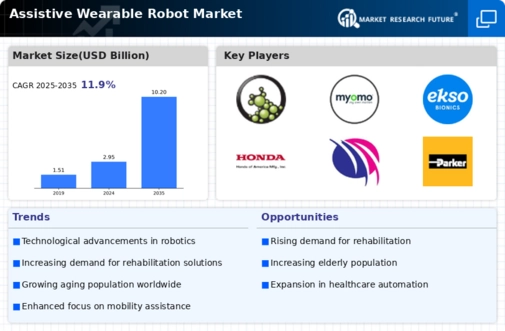Market Growth Projections
The Global Assistive Wearable Robot Market Industry is projected to experience substantial growth over the next decade. With a market valuation of 2.95 USD Billion in 2024, it is anticipated to reach 10.2 USD Billion by 2035. This growth trajectory suggests a compound annual growth rate of 11.92% from 2025 to 2035. Such projections indicate a robust demand for assistive wearable robots, driven by factors such as technological advancements, an aging population, and increased healthcare expenditure. The market's expansion reflects a broader trend towards integrating innovative solutions into healthcare, aiming to improve the quality of life for individuals with mobility challenges.
Increasing Aging Population
The Global Assistive Wearable Robot Market Industry is experiencing growth driven by the increasing aging population. As individuals age, they often face mobility challenges, leading to a rising demand for assistive technologies. In 2024, the market is valued at approximately 2.95 USD Billion, reflecting the urgent need for solutions that enhance mobility and independence among seniors. Countries with significant elderly populations, such as Japan and Germany, are particularly focused on integrating wearable robots into healthcare systems. This demographic shift suggests a sustained demand for innovative assistive devices, potentially propelling the market further as the population continues to age.
Rising Healthcare Expenditure
The Global Assistive Wearable Robot Market Industry is also influenced by rising healthcare expenditure across the globe. Governments and private sectors are increasingly investing in healthcare technologies to improve patient outcomes and reduce long-term care costs. This trend is particularly evident in countries like the United States, where healthcare spending is projected to reach 20% of GDP by 2028. Such investments facilitate the development and adoption of assistive wearable robots, which can help alleviate the burden on healthcare systems. The anticipated compound annual growth rate of 11.92% from 2025 to 2035 indicates that this driver will significantly impact market dynamics in the coming years.
Technological Advancements in Robotics
Technological advancements play a crucial role in the Global Assistive Wearable Robot Market Industry. Innovations in robotics, artificial intelligence, and sensor technologies are enhancing the functionality and usability of wearable robots. These advancements enable devices to provide better support for users, improving their quality of life. For instance, the integration of AI allows for adaptive learning, where robots can adjust to the user's specific needs over time. As these technologies evolve, the market is expected to grow significantly, with projections indicating a market size of 10.2 USD Billion by 2035. This growth underscores the importance of continuous innovation in driving market expansion.
Growing Awareness of Assistive Technologies
Growing awareness of assistive technologies is a key driver for the Global Assistive Wearable Robot Market Industry. As more individuals and healthcare professionals recognize the benefits of wearable robots, demand is likely to increase. Educational initiatives and advocacy campaigns are helping to inform the public about the potential of these devices to enhance mobility and independence. This heightened awareness is particularly important in developing regions, where access to assistive technologies has traditionally been limited. As awareness spreads, it is expected that more users will seek out these solutions, contributing to the overall growth of the market.
Increased Focus on Rehabilitation Solutions
The Global Assistive Wearable Robot Market Industry is witnessing an increased focus on rehabilitation solutions. Healthcare providers are increasingly adopting wearable robots for rehabilitation purposes, as they offer effective support for patients recovering from injuries or surgeries. These devices can assist in physical therapy by providing resistance and support, thereby enhancing recovery outcomes. The integration of wearable robots into rehabilitation programs is becoming more common, particularly in advanced healthcare systems. This trend is expected to drive market growth, as more facilities recognize the benefits of incorporating assistive technologies into their rehabilitation protocols.





















